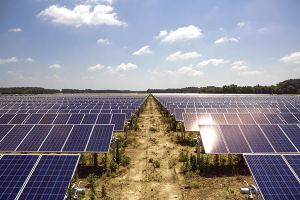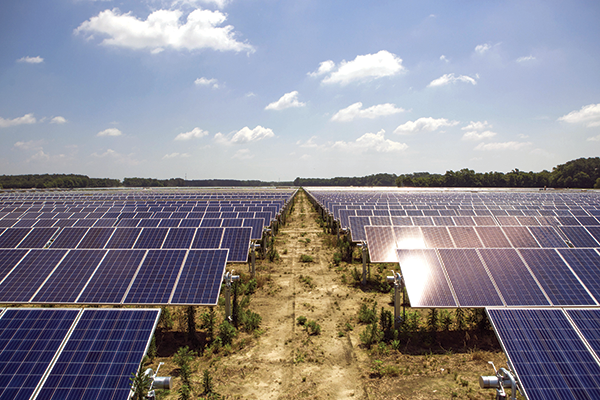By Alexis Laundry
The Commonwealth of Virginia has emerged practically overnight as a leader in solar energy development. Previously dubbed the “darkest state” by solar developers, in 2020 the Commonwealth ranked 4th in the nation for solar development.[1] The catalyst for this change was the General Assembly’s passage of the Virginia Clean Economy Act (VCEA) in April of 2020, which has been called “the single largest shift in energy policy as it relates to the electricity sector that’s ever been achieved in any state.”[2] The landmark omnibus energy package established ambitious targets for zero-carbon emissions, renewable energy deployment, energy efficiency standards, and more.[3] It completely reshaped the regulatory landscape for Virginia’s two major public utilities, Dominion and APCo, and forces compliance with the state’s sustainability goals by establishing mandatory renewable portfolio standards and development goals.[4] The 2021 RPS requirements include 6% of annual sales from renewable sources for APCo and 14% for Dominion.[5] Both utilities also have specific renewable energy development targets: 600 megawatts of APCo capacity by 2030 and 16,100 megawatts of Dominion capacity by 2035.[6] The overall goal is to reach 100% renewable energy by 2050 and net-zero carbon emissions by 2045.[7]
The VCEA became effective in July 2020. Now, more than a year later, we can see that it’s achieving its purpose, especially when it comes to solar development. The new requirements have led to a solar explosion across that state that puts Virginia on track to become one of the largest producers of solar energy in the nation.[8] According to SEIA, over 1,400 MW of solar capacity was installed in 2020 (ranking 4th) and 236 MW was installed during the first quarter of 2021(ranking 5th), the vast majority of which came from utility-scale development.[9] The 2021 Q1 deployment alone is more than the state’s annual deployment in 2018 and 2019.[10] The number of installations across the state total 19,797, which provide 2.57% of the state’s electricity.[11] There’s still a long way to go in order to meet the 2050 goal of 100% renewable energy, but this is encouraging progress that shows the transition is not only possible, but can be rolled out quickly.
One of the most important factors contributing to the success of the program over the last year is support from local governments, who control where the newly required renewable energy projects will be located. In general, local governments have responded positively to the VCEA. There has been an increase in the number of projects approved and localities have been working to update their planning policies and regulations to allow for more solar and wind development.[12] This positive response is partly due to other laws enacted in 2020 that gave localities more tools to maximize revenue and minimize risks from solar projects.[13] These laws include a Solar Revenue Share law that allows localities to assess up to $1,400 per megawatt of capacity;[14] new rules allowing localities to require solar siting agreements or conditions to permits that provide for cash payments for certain capital needs or assisting the locality with infrastructure projects;[15] and changes to the tax exemptions that apply to solar equipment that will allow localities to collect more tax revenue over the life of the project.[16] By taking advantage of these new laws, localities can reap more benefits from solar projects than before, such as upfront cash payments or assistance with broadband deployment.[17] These options serve as powerful incentives for local governments to approve more projects and make their counties attractive to further development by reducing barriers in their permitting process.
On the other hand, not everyone is satisfied with the increased pace and volume of solar deployment in the state; a major barrier to projects making it into the ground is organized public opposition.[18] For example, last May Culpeper County denied a permit for a large solar project after more than 30 people participated in the public hearing before the Board of Supervisors, the vast majority of which expressed vehement opposition.[19] The complaints embodied classic NIMBY arguments,[20] including concerns about losing the county’s rural character, environmental damage, noise and traffic during construction, and impacts to historic sites, such as Revolutionary War and Civil War battlegrounds.[21] In the end, public opinion obviously swayed the Board, which unanimously voted to reject the application, despite at least two Board members believing the project was in accordance with the county’s Comprehensive Plan.[22] Board meetings just like this have led to many proposed solar farms being denied permits, despite projects seeming to meet all county requirements.[23] This trend is a clear sign that supportive local regulations, and even local government bodies, by themselves are not enough to get solar into the ground. The next step is convincing the people in these communities that these projects are more beneficial than detrimental and finding ways to compromise so that counties can reap the benefits of hosting solar farms while preserving their character. This roadblock is not insurmountable, but it will take a coordinated effort by developers, state and local governments, and the utilities to overcome.
[1] Elizabeth McGowan, As policy impacts kick in, Virginia climbs into top five states for solar, Energy News Network (June 15, 2021), https://energynews.us/2021/06/15/as-policy-impacts-kick-in-virginia-climbs-into-top-five-states-for-solar/; Virginia Solar, Solar Energy Indus. Ass., https://www.seia.org/state-solar-policy/virginia-solar (last visited Sept. 24, 2021).
[2] Sarah Vogelsong, Virginia’s Clean Energy Transition: A special series by the Virginia Mercury, Virginia Mercury (Nov. 30, 2020), https://www.virginiamercury.com/2020/11/30/virginias-clean-energy-transition-a-special-series-by-the-virginia-mercury/.
[3] Virginia Clean Economy Act, 2020 Va. Acts ch. 1194.
[4] Id. at pp. 21–24.
[5] Id. at p. 22.
[6] Id. at p. 23.
[7] Id. at pp. 21–22.
[8] Virginia Solar, supra note 1 (projecting a growth of 5,872 MW over the next 5 years, which ranks 5th in the nation).
[9] Id.; see also McGowan, supra note 1.
[10] McGowan, supra note 1.
[11] Virginia Solar, supra note 1.
[12] See, e.g., Sylvia Allen, Supervisors, Planning Commission work on Solar Facilities Ordinance, Brunswick Times-Gazette (Mar. 24, 2021), https://www.brunswicktimes-gazette.com/article_111a9ca0-8bf1-11eb-94ad-73b1098a0f2f.html.
[13] New laws offer better deal for solar hosts, SoVaNow.com (Aug. 12, 2020), http://www.sovanow.com/index.php?/news/article/new_laws_offer_better_deal_for_solar_hosts/.
[14] S.B. 762, 2020 Sess. (Va. 2020).
[15] H.B. 1675, 2020 Sess. (Va. 2020); H.B. 655, 2020 Sess. (Va. 2020).
[16] H.B. 1434, 2020 Sess. (Va. 2020).
[17] New laws offer better deal for solar host, supra note 13.
[18] Allison B. Champion, Culpeper County Board denies Maroon Solar power plant project, Culpeper Star-Exponent (May 5, 2021), https://starexponent.com/news/culpeper-county-board-denies-maroon-solar-power-plant-project/article_77dcd980-0e0a-5f37-9445-f6fdfa6e8659.html.
[19] Id.
[20] See Linda Poon, When Residents Support Solar—Just ‘Not in My Backyard’, Bloomberg (Nov. 20, 2019), https://www.bloomberg.com/news/articles/2019-11-20/how-to-get-around-solar-energy-s-nimby-problem.
[21] Champion, supra note 18.
[22] Id. (A key criteria for project approval is finding that the project is in accordance with the county’s Comprehensive Plan for land use and development).
[23] See, e.g., Laura Peters, Augusta County solar project not in accord with comprehensive plan, per planning commission vote, Staunton News Leader (Jan. 14, 2021, 12:15 PM), https://www.newsleader.com/story/news/2021/01/13/augusta-county-solar-projects-special-use-permit-denied-after-hours-long-public-hearing/6636612002/; Jimmy LaRoue, Whaleyville solar farm denied, Suffolk News-Herald (June 16, 2021, 11:29 PM), https://www.suffolknewsherald.com/2021/06/16/whaleyville-solar-farm-denied/.

Image Source: https://www.virginiabusiness.com/article/sunny-days-ahead-for-solar
